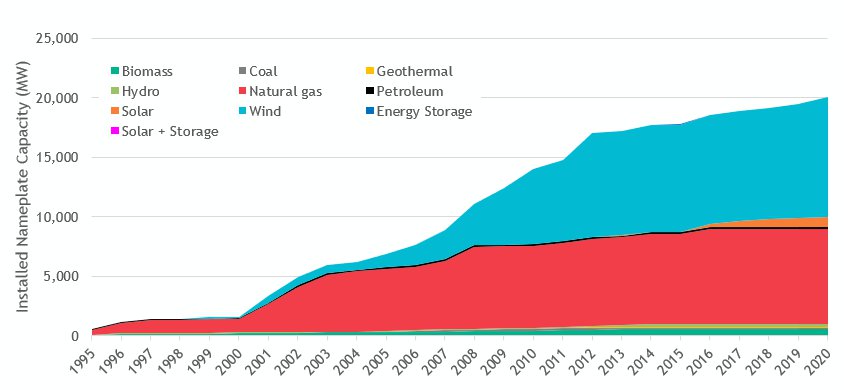Over the past quarter century, new resource technologies have become commercially available and new power plants have been introduced to the regional resource portfolio. The 2000’s kicked off a decade of significant development in the region, with new natural gas plants coming online in part as a response to the West Coast energy crisis. State renewable portfolio standards (RPS) were adopted in California, Montana, Washington, and Oregon in the mid-2000’s, which combined with federal tax incentives, spurred a decade of increasing wind development in the Pacific Northwest, culminating in the biggest year of development in 2012. As utilities were on track to comply with near-term RPS targets, and uncertainty over the continuation of tax incentives affected developer’s ability to secure funding, development slowed after 2012. Following a few years of residential and commercial solar photovoltaic (PV) developments, utility scale solar PV began to appear in southern Idaho and southeastern Oregon. Many of these early projects were qualifying facilities driven by the Public Utility Regulatory Policies Act (PURPA), but as the cost of solar PV dropped quickly and significantly, more solar projects came through the development pipeline.
Very few significant regional resources – in terms of major contributions to the region’s power supply - have been retired until recently. In the late 2000’s and early 2010’s, as demand for paper and newsprint declined, several local wood product manufacturers suspended operations. This led to the closures of several natural gas cogeneration facilities, as well as biomass plants that relied on the biofuel waste produced from the paper industry. In 2014, Transalta’s Big Hanaford combined cycle gas plant that accompanied the Centralia coal units was disassembled and sold for parts. A few small hydro projects were retired between 2010-2013, including the removal of Condit Dam and the Elwha and Glines dams as part of environmental restoration and salmon recovery efforts.
The first year of major coal unit retirements kicked off in 2020, with the decommissioning of Colstrip units 1 and 2 in January, Boardman in October, and Centralia unit 1 in December.
For more information on generating resources in the region, through history, see “Description of Existing Fleet by Generating Resource.”
New Resource Additions and Resource Retirements Since 1995

Cumulatively, the region added about 20,000 megawatts of new installed nameplate capacity over the past 25 years. Of that, about 50% was new wind (~10,000 megawatts) and 40% was new natural gas (~8,000 megawatts). While these resources were developed in the region – or built outside the region with energy sales agreements to the region – some of these resources, in particular about 1/3 of the wind projects, were developed to meet energy requirements and renewable portfolio standards outside of the region.
Cumulative Resource Additions Over the Past Quarter Century

For more details on the past five years, see “Additions and Retirements since the Seventh Power Plan.” For more information on generating resource technologies throughout history in the region, see “Description of Existing Fleet by Generating Resource.”



